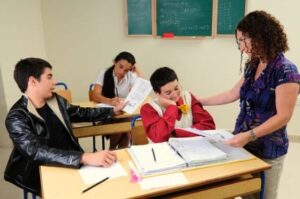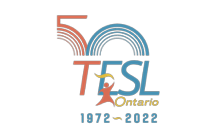Marking is one of the most headache-inducing and complicated tasks that ESL teachers are required to perform. Correcting students’ mistakes and giving students a mark is merely the tip of the iceberg when we talk about overall assessment and evaluation.
This TESOL blog reviews the differences between assessment and evaluation in the ESL classroom, and offers advice to help you tackle the challenging task of evaluating speaking skills.
Recommended: Take an internationally recognized TESOL course with OnTESOL! Self-paced and semi-asynchronous online TESOL courses with live lesson planning workshops
Assessment in TESOL
When ESL teachers assess students’ progress, they first need to check on the lesson objectives. Then the teacher needs to come up with a method for checking that their students have achieved the proficiency level that was expected of them.
 A good assessment should inform the teacher if the ESL lesson was effective and how it can be improved. A good assessment should also be the base for further planning since new concepts should not be taught until the students have achieved the objectives.
A good assessment should inform the teacher if the ESL lesson was effective and how it can be improved. A good assessment should also be the base for further planning since new concepts should not be taught until the students have achieved the objectives.
For example, if the teacher taught the Present Perfect tense to express past actions that continue onto the present, one form of assessment would be to ask them to write down sentences or a paragraph that is autobiographical. Once this is done, the teacher should check the students’ work and look for evidence of learning in the correct use of the grammatical structure (have or has + main verb in past participle form) as well as in the context and meaning portrayed in their work.
Helping ESL students identify their mistakes and correct them is how assessment dictates the next steps in the lessons to be taught. It is important to remember that the assessment does not require the teacher to give the students ‘a mark.’ It is far more important at this stage that students are alerted about their mistakes, are taught to find them themselves, and most importantly, they are taught to correct them and re-learn concepts that were missed the first time the topic was introduced.
Once this process has finished, the teacher can move on to the next step.
OnTESOL students receive lifetime free job assistance and access to the TEFL job board.
Evaluation in TESOL
Evaluation is the task of assigning marks, grades or percentages that represent how well students have learned the skills or concepts taught. Evaluation can help the teacher look back in retrospect and decide whether the assessment of the students was accurate and whether the reinforcement of concepts was effective. More importantly, evaluating the students will give ESL students the feedback they need in regards to their learning so they can also decide whether their approach to learning the new language is effective or needs to be changed somehow.
It is important to plan our ESL lessons carefully and consider when it is necessary to include assessments to help the students review topics, and when it is necessary to include evaluations in order to determine whether or not the objectives were met.
One of the most challenging tasks that ESL teachers need to fulfil is evaluating their students. After many years in the profession, it is sometimes a little easier to gauge whether students are improving while taking the class. However, this ballpark impression, which can sometimes be based on experience and instinct, is very difficult to quantify and prove. And, it is far from accurate. For this reason, ESL teachers must learn and develop a trustworthy method of evaluating their students in order to provide evidence of their students’ progress and improvement.
What is Being Evaluated in the ESL Classroom?
It is adamant that, as a teacher, you can clearly identify what is being tested or evaluated with each exercise or task. The real aim of the exercise must be straightforward and clear. For example, if the goal of an exercise is to test a student’s knowledge of vocabulary only, marks should be awarded or taken away only for mistakes or correct answers in this area and not for other grammar mistakes when the student writes example sentences.
Ideally, the task or exercise should be built efficiently so this possible confusion is avoided. A better way of testing vocabulary would be to ask students to complete sentences already written or to match the vocabulary word to the correct definition. This kind of exercise would test the students’ comprehension and recognition of the vocabulary. However, if the aim is to test the students’ use of the vocabulary word correctly, sometimes doing this efficiently can be more complicated.
Recognition vs Production
Evaluating comprehension and recognition is generally easier and marking more accurately than when evaluating a student’s ability to speak or write in a second language.
Following the example above, testing whether a student can use certain vocabulary words correctly can lead to other kinds of mistakes if the student is asked to write the definition of these words or to use these words in sentences of their own.
The best way of evaluating their ability to use the new vocabulary is to try and ignore all other mistakes that may surround the new vocabulary. Furthermore, students must understand that in order to prove their knowledge of these words, they must use them in sentences that denote their meaning clearly. The possibility that students might not understand the instructions, or that their grammar mistakes obscure the meaning of the vocabulary words, makes testing of a student’s writing skills more challenging.
Similarly, when evaluating speaking skills, the above needs to be taken into consideration as well. Added to this, aspects like pronunciation, fluency and intonation also play an important part in enhancing or hindering a student’s ability to speak clearly and complete a speaking task successfully, so they should also be accounted for in the marking scheme.
In order to avoid further confusion, and for straightforward marking, the teacher needs to create one exercise to evaluate each objective or skill. When more than one exercise is used to evaluate one skill, it is suggested that one be a recognized type of exercise while the other requires the student to produce (write or speak) in order to have some balance in the evaluation.
Levels, Benchmarks, Checklists and Rubrics
When evaluating ESL students’ performance in learning and improving their language skills, it is important for teachers to have a clear list of goals or expectations. Standardized tests and other testing methods have come up with benchmarks, levels and rubrics that teachers can use in order to evaluate their students.
ESL teachers can use general ones if they have them available, or they can create their own, which will often be better for them. Using these ‘checklists’ will improve the teacher’s objectivity and fairness when evaluating the students. Furthermore, it will make marking a less daunting and taxing task, while at the same time the results will be more accurate.
OnTESOL -Online TESOL courses recognized by TESL Canada since 2003-
Evaluating Speaking Skills
Giving students a mark for their oral work is one of the hardest jobs a teacher needs to fulfil. Listening for content as well as the delivery of the language is a challenge in and of itself. Add having to evaluate these aspects of a students’ speech and the task becomes even harder.
Evaluating students’ speaking skills is difficult because there are so many things to pay attention to at the same time. One possible solution for this is to concentrate on one or two aspects at a time. For example, for a particular speaking task, the teacher can focus on marking content and word stress; while for the next, the teacher can focus on intonation and linking sounds correct.
Another solution is to record students’ speeches and listen to them more than once in order to focus on more aspects of their work. However, it is recommendable to focus on one or two aspects every time a teacher listens to the speech in order to be able to provide reliable feedback with examples.
If the above suggestions are not possible because they can be very time consuming, or because the means are not available, using rubrics can make evaluating speaking skills a more attainable task. Rubrics should be created based on the expectations for each assignment or task and teachers can adjust them to the needs of their class or the regulations put forward by their school or ministry of education.
As long as ESL teachers are familiar with the rubric and its contents, they can listen to the presentation and pay attention to it while placing quick checkmarks in the correct areas as the student performs. Later, the mark or grade can be calculated as an average or based on whichever proportion is assigned to the different areas.
TESOL guide: Learn more about teaching English abroad and teaching English online.






